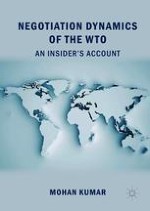2018 | OriginalPaper | Buchkapitel
4. India at the WTO: Punching Above Its Weight
verfasst von : Mohan Kumar
Erschienen in: Negotiation Dynamics of the WTO
Verlag: Springer Singapore
Aktivieren Sie unsere intelligente Suche, um passende Fachinhalte oder Patente zu finden.
Wählen Sie Textabschnitte aus um mit Künstlicher Intelligenz passenden Patente zu finden. powered by
Markieren Sie Textabschnitte, um KI-gestützt weitere passende Inhalte zu finden. powered by
